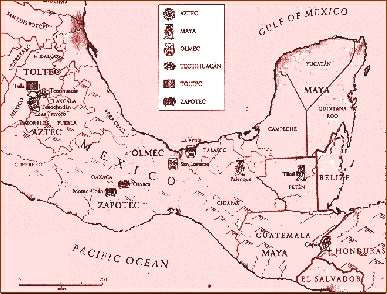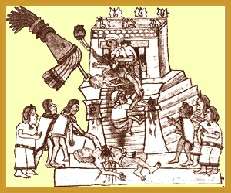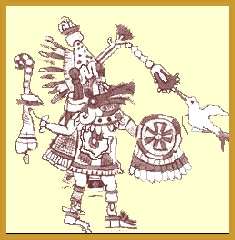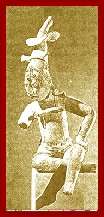| PinkMonkey Study Guide - American History
Later, new civilizations emerged. Among them were
the Toltecs, with their capital city called Tula.
This city soon became a center for soldiers and merchants who controlled
the entire region of ancient Mexico and Central America. But in
the 12th century, Tula was razed to the ground, and the people had
to flee. The Toltecs were followed by the Aztecs. The Aztec
Empire is considered to be one of the greatest in South America.
Their ancestors were the Mexicas, who had come to the valley
of Mexico during the 12th century. By 1325, the Aztecs had built
cities and adopted an urban way of life. The Aztec capital - Tenochtitlan
was built in 1325. When the first European, a Spaniard Hernando
Cortez came to the city in 1519, more than 60,000 merchants came
to the great market place of the city. Also, the size of the capital
was bigger than any other European city, with the exception of London.
The Empire sustained on field agriculture on reclaimed, but fertile
land called the Chinampas. The remains of the ’Chinampas’
can still be seen near Mexico.
The Aztec Empire had a huge standing army, which
was feared by everybody in the South American region. In the 15th
century, these troops built a huge Empire that gave them a lot of
wealth and goods by way of tributes from the other tribes and states.
When Cortez arrived in the capital city of the Aztecs, the huge
Empire was ruled over by Montizuma II. In the city of Tenochtitlan,
there were huge hospitals and surgeons who were as advanced as their
counterparts in Europe. And in her temples, priests sacrificed more
than twenty thousand war-captives to the war god - Huitzilopochtli.
The Aztec society can be called ’modern’, as it had developed a
definite class structure, with the nobles, army officers
and the priests who formed the elite; while the farmers, craftsmen,
traders and soldiers formed a part of the commoners. The elite section
looked after the governance of the Empire. They wrote books and
controlled the economy. The people of the Aztec Empire had developed
a script, which can be seen on their monuments and in their written
texts.
The Pre-Columbian Civilizations of Middle America

Click Here to Enlarge
Exhibit 1.4
The Mayans
The Mayans were contemporaries of the Olmecs. While the latter
civilization declined and disappeared, the Mayans, by AD 300 had
developed a remarkably advance culture, which flourished till AD
900. From the ruins, scholars have gathered that the Mayans had
built huge and aesthetically beautiful temples. Besides their monumental
architecture, the Mayans had also advanced in astronomy, recording
their observations in screen folds (books made of lime covered bark
paper). Mayan writers also wrote calendrical religious inscriptions
on ceramic vessels. These inscriptions and records reveal that the
Mayans had a well-developed script. Known to be a peaceful people,
who believed in the policy of ’live and let live’, this civilization
buckled under the onslaught of the weapon wielding Spaniards.
AZTEC sacrifices to the war god

Exhibit 1.5
An Aztec God

Exhibit 1.6
Indians in North America
In North America, the Indians did not settle down to do agriculture due to the climatic conditions. Thus, they did not make the advances their counterparts made in the South American continent. There were various tribes like Beaver, Chippewe, Cree, Chowo, Yellow Knife, Mohegans, etc. Since the growing season was too short for agriculture, they gathered plants, nuts and berries. Hunting and fishing were the chief activities. As far as shelter was concerned, nomadic tribes used portable ’tepees’; while the others built strong log homes to stay. Communal sharing extended to land use, the hunt and the home. Although one particular family ploughed a piece of land, they did not own it. It belonged to the entire tribe. The women especially from the Iroquois tribe played a major role in political matters. In this tribe (Iroquois) which lived in villages, married men stayed or joined the family of their wires. And while the women did the farming, the men went out to hunt, fish and war. So influential was the authority of the women in this tribe, that they sometimes prevented military expeditions by refusing to supply food or footwear. Within the tribe, there was a healthy spirit of competition in hunting, fishing and fighting, children were brought up on egalitarian values. Without any written laws or jails, order and discipline was maintained, by way of ostracism. Though civilized, their lack of technological knowledge - especially in the used of weapons, rifles, etc. and a lack of unity between the various tribes were the 2 main reasons for their inability to resist the European onslaught in the New World.
Initially, these tribes accepted the white foreigners in their midst, and helped them to adjust and learn about their new environment. However, soon a bitter struggle ensued. For as European settlements increased, land grabbing and the control of fur trade at the expense of the native Indians caused a long, bloody war in the north. Not content with cattle raising and sugar plantations, the Spanish Monarchy wanted wealth to fill their coffers. Moreover, rumors were afloat about the existence of civilizations in Mexico and South America, known for their wealth.
A Mayan Ceramic

Exhibit 1.7
Learning about their vast treasure in gold and
silver, Spain sent an expedition under Hernando Cortez to
conquer the Aztecs. Within a few months the Aztecs were defeated
and their ruler, Montezuma II was slain. But the looting, killing
and plunder in the Aztec capital continued for almost 2 years. Cortez
and his men went on to destroy the Mayan civilization in the central
part of South America. In 1532, Francisco Pizzaro led his
men to conquer the Incas. Here again the city was plundered,
hundreds of Inca men, women and children were massacred along with
their leader, Atahmalpa. The Spanish could easily conquer
and subjugate these kingdoms mainly due to their superior weapons
- the gun power. These brutal Spanish conquests poured a lot of
wealth into the Spanish coffers. It is perhaps due to these conquests,
that several historians argue: America was not discovered, but
conquered.
[Next Page]
|
Table
of Contents
1.0
- Chronology of Major Events in this Period
1.1 - The Discovery of America
1.2 - Voyages of exploration
1.3 - The Indians
1.4 - Points to Remember
Chapter 2
|